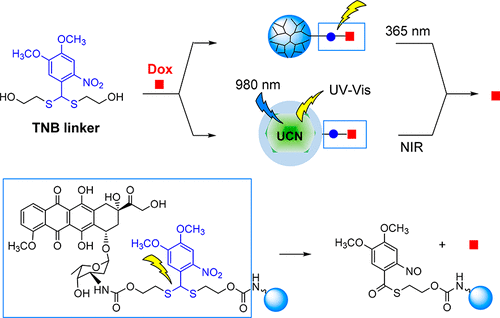当前位置:
X-MOL 学术
›
Bioconjugate Chem.
›
论文详情
Our official English website, www.x-mol.net, welcomes your
feedback! (Note: you will need to create a separate account there.)
Photocontrolled Release of Doxorubicin Conjugated through a Thioacetal Photocage in Folate-Targeted Nanodelivery Systems
Bioconjugate Chemistry ( IF 4.0 ) Pub Date : 2017-12-06 00:00:00 , DOI: 10.1021/acs.bioconjchem.7b00614 Pamela T. Wong , Shengzhuang Tang , Jayme Cannon , Dexin Chen 1 , Rachel Sun , Jennifer Lee , James Phan , Ke Tao 1 , Kang Sun 1 , Biqiong Chen 2 , James R. Baker , Seok Ki Choi
Bioconjugate Chemistry ( IF 4.0 ) Pub Date : 2017-12-06 00:00:00 , DOI: 10.1021/acs.bioconjchem.7b00614 Pamela T. Wong , Shengzhuang Tang , Jayme Cannon , Dexin Chen 1 , Rachel Sun , Jennifer Lee , James Phan , Ke Tao 1 , Kang Sun 1 , Biqiong Chen 2 , James R. Baker , Seok Ki Choi
Affiliation

|
Despite their proven ability for precise and targeted release, nanoplatform systems for photocontrolled delivery often face formidable synthetic challenges, in part due to the paucity of advanced linker strategies. Here, we report on a novel linker strategy using a thioacetal ortho-nitrobenzaldehyde (TNB) cage, demonstrating its application for delivery of doxorubicin (Dox) in two nanoscale systems. This photocleavable linker, TNB(OH), which presents two identical arms, each terminated with a hydroxyl functionality, was prepared in a single step from 6-nitroveratraldehyde. TNB(OH) was used to cross-link Dox to a folate receptor (FAR)-targeting poly(amidoamine) dendrimer conjugate G5(FA)n=5.4(Dox)m=5.1, and also used to prepare an upconversion nanocrystal (UCN) conjugate, UCN–[email protected](Dox)(G5FA), a larger core/shell nanostructure. In this core/shell nanostructure, the UCN core emits UV and visible light luminescence upon near-infrared (NIR) excitation, allowing for the photocleavage of the TNB linker as well as the photostimulation of protoporphyrin IX (PPIX) coupled as a cytotoxic photosensitizer. Drug-release experiments performed in aqueous solutions with long-wavelength ultraviolet A (UVA) light showed that Dox release occurred rapidly from its TNB linked form or from its dendrimer conjugated form with comparable decay kinetics. Cellular toxicity studies in FAR-overexpressing KB carcinoma cells demonstrated that each nanoconjugate lacked intrinsic cytotoxicity until exposed to UVA or NIR (980 nm) (for the UCN nanoconjugate), which resulted in induction of potent cytotoxicity. In summary, this new TNB strategy offers synthetic convenience in drug conjugation chemistry with the ability for the temporal control of drug activation at the delivery site.
中文翻译:

叶酸靶向的纳米传递系统中通过硫缩醛光笼结合的阿霉素的光控释放。
尽管已证明其具有精确和定向释放的能力,但用于光控递送的纳米平台系统通常仍面临着巨大的合成挑战,部分原因是缺乏先进的接头策略。在这里,我们报告了一种使用硫缩醛邻硝基苯甲醛(TNB)笼的新型连接子策略,证明了其在两个纳米级系统中递送阿霉素(Dox)的应用。该光可裂解的连接体TNB(OH)具有两个相同的臂,每个臂均带有羟基官能团,是由6-硝基藜芦醛一步制得的。TNB(OH)用于将Dox交联到靶向叶酸受体(FAR)的聚(酰胺基胺)树状聚合物共轭物G5(FA)n = 5.4(Dox)m = 5.1,还用于制备上转换纳米晶体(UCN)共轭物,UCN- [电子邮件保护](Dox)(G5FA),一种较大的核/壳纳米结构。在此核/壳纳米结构中,UCN核在近红外(NIR)激发后会发出UV和可见光发光,从而允许TNB接头的光裂解以及作为细胞毒性光敏剂偶联的原卟啉IX(PPIX)的光刺激。在水溶液中用长波紫外线A(UVA)进行的药物释放实验表明,Dox释放是从其TNB连接形式或其树枝状大分子共轭形式迅速发生的,并且具有相当的衰减动力学。在过表达FAR的KB癌细胞中进行的细胞毒性研究表明,每个纳米复合物在暴露于UVA或NIR(980 nm)(对于UCN纳米复合物)之前都没有固有的细胞毒性,导致有效的细胞毒性的诱导。综上所述,这种新的TNB策略在药物结合化学中提供了合成便利,并具有在递送位点暂时控制药物活化的能力。
更新日期:2017-12-06
中文翻译:

叶酸靶向的纳米传递系统中通过硫缩醛光笼结合的阿霉素的光控释放。
尽管已证明其具有精确和定向释放的能力,但用于光控递送的纳米平台系统通常仍面临着巨大的合成挑战,部分原因是缺乏先进的接头策略。在这里,我们报告了一种使用硫缩醛邻硝基苯甲醛(TNB)笼的新型连接子策略,证明了其在两个纳米级系统中递送阿霉素(Dox)的应用。该光可裂解的连接体TNB(OH)具有两个相同的臂,每个臂均带有羟基官能团,是由6-硝基藜芦醛一步制得的。TNB(OH)用于将Dox交联到靶向叶酸受体(FAR)的聚(酰胺基胺)树状聚合物共轭物G5(FA)n = 5.4(Dox)m = 5.1,还用于制备上转换纳米晶体(UCN)共轭物,UCN- [电子邮件保护](Dox)(G5FA),一种较大的核/壳纳米结构。在此核/壳纳米结构中,UCN核在近红外(NIR)激发后会发出UV和可见光发光,从而允许TNB接头的光裂解以及作为细胞毒性光敏剂偶联的原卟啉IX(PPIX)的光刺激。在水溶液中用长波紫外线A(UVA)进行的药物释放实验表明,Dox释放是从其TNB连接形式或其树枝状大分子共轭形式迅速发生的,并且具有相当的衰减动力学。在过表达FAR的KB癌细胞中进行的细胞毒性研究表明,每个纳米复合物在暴露于UVA或NIR(980 nm)(对于UCN纳米复合物)之前都没有固有的细胞毒性,导致有效的细胞毒性的诱导。综上所述,这种新的TNB策略在药物结合化学中提供了合成便利,并具有在递送位点暂时控制药物活化的能力。











































 京公网安备 11010802027423号
京公网安备 11010802027423号